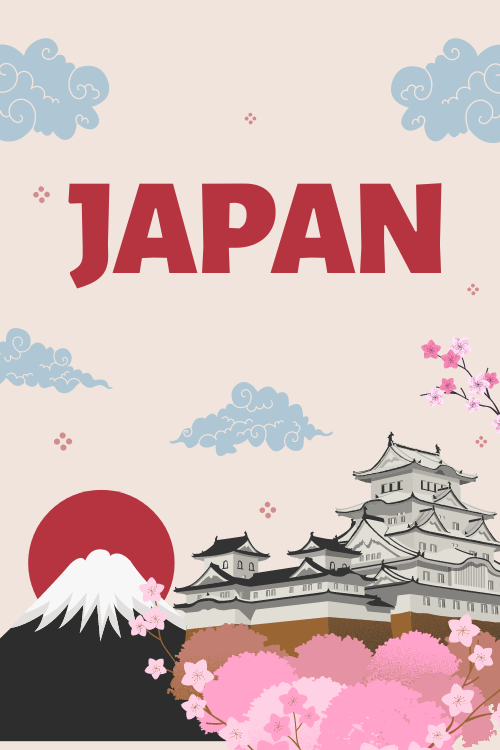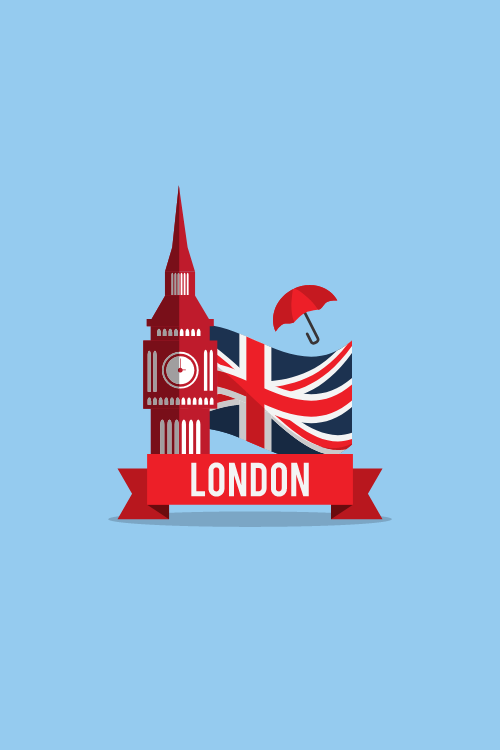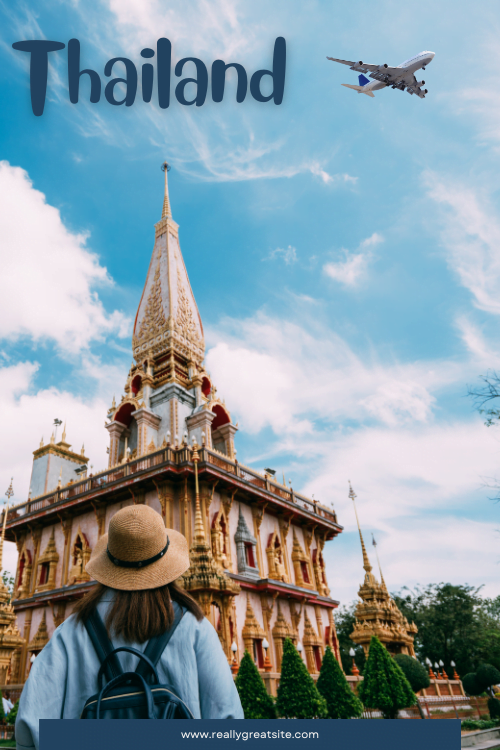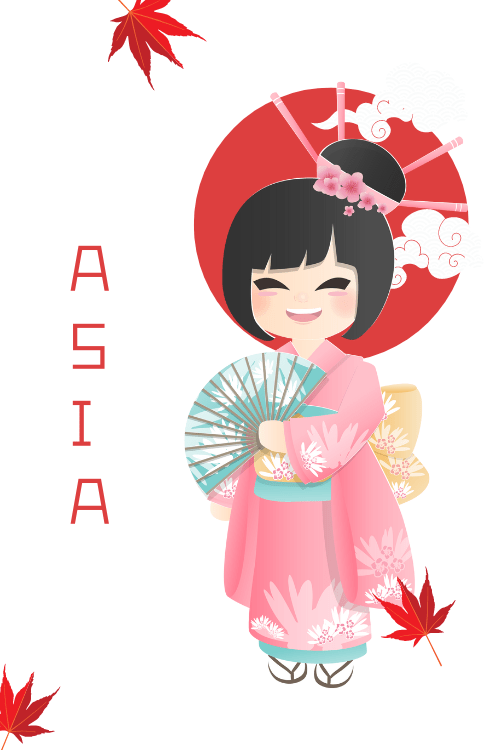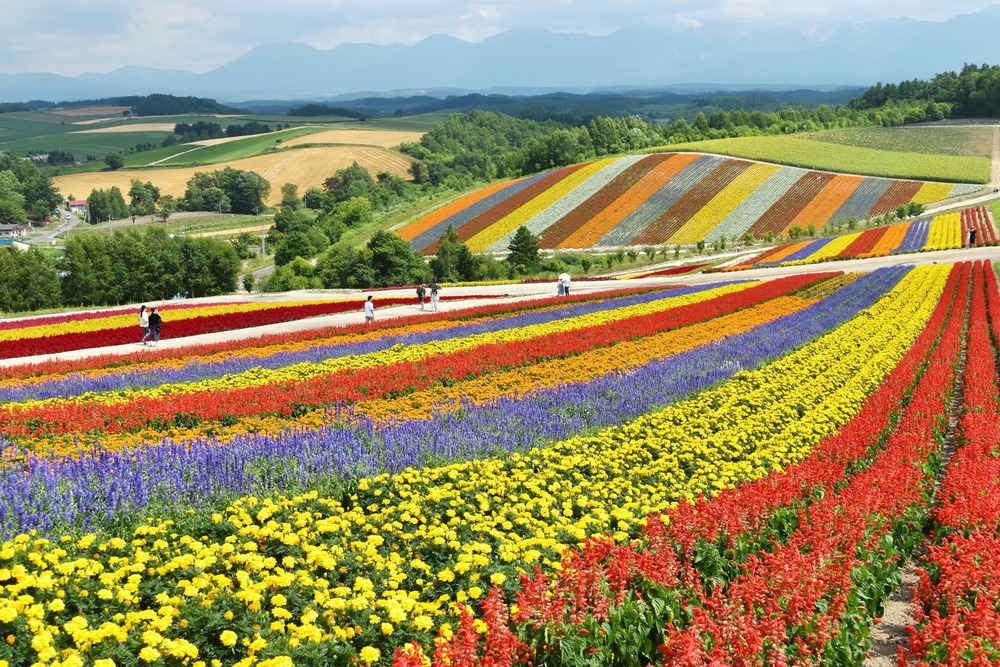Best Time To Visit, eSIM Japan
Best Time to Visit Hokkaido? The Ultimate Guide
Planning a trip to Hokkaido? You’re in for a treat! This amazing island offers something special all year. Whether you love snowy mountains, bright flower fields, or tasty food, Hokkaido has it. The “best” time truly depends on what you want to see and do. This guide helps you pick your perfect season by looking at weather, fun activities, crowds, and costs.
Hokkaido’s Year-Round Allure: Finding Your Perfect Season
Why Hokkaido Captivates
Hokkaido is Japan’s stunning northern island. It calls to travelers with diverse, captivating experiences. These change dramatically with each season. Winter turns Hokkaido into a powdery wonderland. Summer brings vibrant carpets of flowers. Hokkaido is famous for its amazing powder snow and beautiful landscapes. Yet, its charm goes far beyond ski slopes.
So, when is the best time to visit?
This guide answers that very question. We will explore Hokkaido’s seasonal beauty. Our goal is to help you find your ideal time to visit. Your choice will match what you love to do. Maybe you seek adventure or quiet relaxation. Perhaps you love culture, food, or saving money.
Many guides try to name one “best” time. This often misses what you want. We know the “best time” is personal. This guide offers a trustworthy, full picture. Think of us as a friendly advisor. We guide you through Hokkaido’s many options. We don’t give rigid rules. This is important for an island with a unique climate. Hokkaido often differs from mainland Japan. Its summers are milder. It sees Japan’s first fall colors.
These differences are key attractions. Maybe you want to escape Honshu’s humid summer. Or you want an early peek at autumn’s colors. Understanding these unique points helps you plan the perfect Hokkaido journey.
Quick Guide: Pinpoint Your Ideal Hokkaido Season Now
Before we dive deep, here’s a quick look. This table compares what each season in Hokkaido offers. It helps you quickly see which time might suit you best. Look at activities, weather, crowds, or costs. This is your starting point for the detailed info below.
Hokkaido Seasonal Snapshot: Plan Your Perfect Trip
| Season | Typical Months | Avg. Temp Range (°C/°F) | Key Highlights/Activities | Crowd Level | Budget Indicator | Why This Season Shines |
|---|---|---|---|---|---|---|
| Spring | Late April – June | Apr: 3-11°C (37-52°F) May: 7-16°C (45-61°F) Jun: 12-20°C (54-68°F) | Cherry blossoms (late Apr-May), spring flowers (tulips, rapeseed), BBQs, early hiking, food tours | Low-Med (except Golden Week) | $ | Fresh weather, beautiful blooms, fewer crowds, moderate prices |
| Summer | July – August | Jul: 16-23°C (61-73°F) Aug: 18-26°C (64-79°F) | Lavender fields (Jul-mid Aug), Biei’s patchwork hills, hiking, outdoor adventures, beer gardens | High (peak season) | $$$ | Pleasant cool weather, vibrant landscapes, prime for all outdoor activities |
| Autumn | September – November | Sep: 14-22°C (57-72°F) Oct: 7-16°C (45-61°F) Nov: 1-9°C (34-48°F) | Earliest fall foliage (Koyo, Sep-Oct), harvest festivals, hiking, onsen, seasonal foods | Low-Med | $ | Spectacular foliage, crisp air, delicious seasonal food, fewer crowds |
| Winter | December – March | Dec: -4-3°C (25-37°F) Jan: -7-0°C (19-32°F) Feb: -7-0°C (19-32°F) Mar: -3-5°C (27-41°F) | World-class powder skiing/snowboarding (Jan-Feb best), snow & ice festivals (Feb), onsen in snow, drift ice (Mar) | High (Jan-Feb), Low (Mar) | $$$ (Jan-Feb), $ (Mar) | Unparalleled snow, magical winter landscapes, world-famous festivals, unique activities |
This “Invisible” SIM Card is Saving Ordinary Travellers Hundreds on International Trips
You see those travelers glide through airport arrivals – calm, internet connected, already booking their ride-share while others are frantically searching for Wi-Fi or queuing at chaotic phone kiosks…
What’s their secret?
When you travel overseas you’re either paying insanely high data-roaming fees from your home carrier or frantically hunting down some local SIM card kiosk the second you land, wasting precious vacation time just trying to get your phone working.
One leaves you with a bill that leaves a sour taste in your mouth after a great trip. The other eats into your actual holiday, causing stress and hassle when you should be exploring.
But what if I told you that ordinary travelers just like you have figured out a way to completely bypass this frustrating experience?
They’re using something most travelers don’t even know exists… a kind of “invisible” SIM card technology that you likely already have on your phone right now.
And it’s allowing them to tap into super-cheap, high-speed data anywhere in the world… without swapping cards, without visiting a store, and without getting ripped off.
It’s called an eSIM.
And eSIM4.com makes getting one simple.
Here’s how it works:
- Step 1: Go to eSIM4.com.
- Step 2: You pick your destination, choose a data plan.
- Step 3: We send you a simple QR code. You scan it with your phone’s camera.
Your new travel SIM is installed in under 3 minutes!
The moment your plane’s wheels hit the tarmac overseas? Your phone instantly connects to a fast, local network.
No queues. No fumbling with tiny plastic chips. No nasty bill shock.
Just seamless, affordable data letting you use Google Maps, WhatsApp, Uber, Instagram… whatever you need… right away.
This is how travel is supposed to work. And it’s saving people like you hundreds of dollars on a single trip.
Stop letting the big phone companies treat your travel budget like their personal ATM. Stop wasting your valuable vacation time being disconnected or stressed.
Join the smart travelers who’ve already made the switch.
CLICK HERE TO GET STARTEDSpring in Hokkaido (Late April – June): Experience Nature’s Awakening
Feel the Change: Spring’s Gentle Arrival
Spring in Hokkaido arrives gently. It comes a bit later than on Japan’s main island, Honshu. Its arrival is truly cherished. Winter’s heavy snow recedes. Snowmelt fills the rivers. You can feel a sense of awakening in the air. This delayed start is a key feature. Spring is a little late here.
Actually, spring in Hokkaido really starts in early May.
Temperatures climb steadily, if sometimes slowly. Mid-April feels mild, around 10°C. April averages 3–11°C (37–52°F). May warms to 7–16°C (45–61°F). June reaches a comfy 12–20°C (54–68°F). This time has great mild weather. It is cool but not winter-cold. It’s not yet summer-warm. Early April can still be chilly. Snow might linger in shady spots. Late May and June feel more like true spring.
What Awaits You: Top Spring Adventures
As winter fades, many activities appear. They celebrate the island’s returning vibrancy.
Cherry Blossoms (Sakura) – Hokkaido’s Late Bloomers:
Cherry blossoms are a top Japan experience. Hokkaido offers a late chance to see them. The blooms here start almost a month later. This is late April to early May. Hokkaido’s cherry blossoms usually peak in May. This timing is great if you missed sakura on Honshu. It’s also often less crowded. Matsumae Park is a top spot. It has around 10,000 cherry trees of 250 types! Some bloom all through May. Goryokaku Park in Hakodate is another famous star-shaped park. Spring is perfect for its cherry blossoms. Hanami (flower viewing) in Hokkaido often feels more relaxed.
Vibrant Spring Flowers Beyond Sakura:
Sakura is famous, but Hokkaido has more spring flowers. Visit Abira for fields of golden rapeseed. Head to Shibazakura Takigami Park. Enjoy hiking and amazing views of pink moss phlox. This carpets the hillsides. Kamiyubetsu Tulip Park shows millions of colorful tulips, usually in May. These flowers add color and fragrance to the land.
Awakening Outdoor Activities:
Warmer weather means outdoor life returns. People get BBQs ready. They enjoy nature as spring offers warmer days. As snow melts, hiking trails open up. Always check conditions for high trails. Pleasant temperatures are ideal for cycling. Explore cities like Sapporo and Otaru. April is good for food tours as roads clear.
Culinary Delights of Spring:
Spring brings tasty seasonal food and fresh seafood. Horsehair crab is a special treat. April is the start of its season. Find it at markets like Sapporo’s Nijo Market. Asparagus, mountain veggies, and early berries also appear. They offer fresh tastes after winter.
Join the Fun: Spring Festivals to Enjoy
Spring has several cultural events. Matsumae Park Hanami Matsuri matches the cherry blossom peak. It has lights and events. The Yosakoi Soran Festival is in early June in Sapporo. It’s a lively dance festival. Thousands of dancers wear colorful outfits. The Hokkaido Shrine Festival (Sapporo Festival) is in mid-June. It’s one of Sapporo’s biggest Shinto festivals. Expect parades and old traditions.
Is Spring Your Season? Weighing the Good and Not-So-Good
So, what are the benefits of a spring visit? Pros: Spring in Hokkaido means great fresh weather. Flowers bloom. Sightseeing gets easier. Compared to summer and winter, you’ll find fewer crowds. Prices are often moderate. Temperatures are usually pleasant for outdoor fun. You avoid intense summer heat or winter cold. If you’ve seen mainland Japan, Hokkaido’s late spring gives a “second chance” for cherry blossoms. The setting is calmer. This is a great plus for repeat visitors. Parts of spring, like March to early April or late May to June (not Golden Week), are cheaper. This makes it good for budget travel.
Cons: The main issue with spring is its unpredictability. Early spring weather can change. Winter’s chill might stay. Some high hiking trails could still be closed by snow. A big thing to note is Japan’s Golden Week holiday. This is usually late April to early May. Popular spots get crowded. Prices for hotels and travel might go up.
Smart Spring Travel: Tips for a Smooth Trip
Pack in layers. Temperatures can change between day and night. Layering clothes is very important. If you travel during Golden Week, book hotels and travel early. For cherry blossoms or other flowers, check local bloom forecasts. Timings change each year with the weather. Early spring, especially April, is a transition time. Some areas are lively, others still feel like winter. Activity options can vary across the island.
Summer in Hokkaido (July – August): Enjoy Vibrant Scenes & Outdoor Fun
Escape the Heat: Hokkaido’s Cool Summer Advantage
Summer in Hokkaido is a refreshing escape. This is true if you know Japan’s usual heat and humidity. The island offers a cooler summer option. This makes it a top choice to avoid hot, humid weather in Honshu. This weather advantage is a big draw. Hokkaido becomes a comfy haven in warmer months.
Average temperatures in July are 16–23°C (61–73°F). August is 18–26°C (64–79°F). Some say summer is generally 15°C to 25°C (59–77°F). Late July/August might get a bit warmer and more humid. But it’s much less than the rest of Japan. Summer also has the longest daylight hours. This gives you plenty of time for outdoor fun.
Staying connected while you explore these vast landscapes is easier than you might think. Consider options like an eSIM for your phone. Companies like eSIM4 offer plans that can auto-connect when you arrive. This means less hassle with finding local SIM cards.
See and Do: Unforgettable Summer Experiences
Hokkaido in summer is an explosion of color, scent, and activity. There are many ways to enjoy its amazing nature.
Iconic Flower Fields in Full Bloom:
Summer means Hokkaido’s stunning flower fields. These draw visitors from everywhere. These vibrant scenes are very “Instagrammable.” This adds to summer’s popularity. Furano’s lavender is a huge star. Lavenders are best in Hokkaido in summer. The peak bloom is usually mid-July to mid-August. Farm Tomita is a famous spot. Fields are covered in dreamy purple lavender. Biei’s rolling hills have amazing flower fields. They look like “patchwork hills” with varied crops and flowers. Shikisai-no-oka is well-known for this beauty. You’ll also see fields of sunflowers, sage, cosmos, and poppies.
Prime Time for Outdoor Adventures:
Pleasant summer weather is perfect for many outdoor activities. Hokkaido becomes a paradise for hikers and nature lovers. Daisetsuzan National Park is Japan’s largest. It has many trails in alpine scenery. Shiretoko National Park is a UNESCO site. It offers rugged coastal hikes and wildlife spotting. Cycling, camping, kayaking, and coastal water sports are all popular.
Coastal Charms & Scenic Drives:
Hokkaido’s long coastline has beautiful beaches and dramatic cliffs. Scenic drives along the coast are popular. Otaru, a historic port town, is lovely in summer. Enjoy a canal ride. See historic buildings by the river. Taste fresh seafood.
Vibrant City Life & Summer Flavors:
Cities like Sapporo buzz in summer. The Sapporo Beer Garden is a classic experience. Locals and visitors enjoy beer and BBQs. This is the true local way to enjoy summer. Summer is also time for Hokkaido’s fresh produce. Enjoy sweet melons and corn. Don’t forget its famous dairy, especially ice cream.
Unkai Terrace (Sea of Clouds):
For a truly magical sight, visit Unkai Terrace at Tomamu Resort. In summer, conditions are often perfect to see a sea of clouds. The sun rises and shines on it. This creates an unforgettable, dream-like view.
Celebrate Summer: Must-See Festivals and Events
Summer is a lively festival season. The Furano Lavender Festival in July marks peak lavender season. It has events in and around Furano. The Doshin/UHB Fireworks Festival is a big fireworks show in Sapporo, usually late July. The Yohtaka Andon Festival in towns like Numata (late August) features lit lantern floats. Many local summer matsuri (shrine festivals) happen island-wide. They offer local traditions, food, and fun.
Summer Calling? The Upsides and Downsides
What makes summer great? Pros: The main pros are pleasant weather (15°C to 25°C or 59–77°F) and few rainy days. This is perfect for the famous flower fields. It’s great for all outdoor activities. The mood is vibrant with many festivals. For many, Hokkaido in summer is the ideal escape from hotter places.
Cons: Summer’s appeal has a big downside: it’s peak tourist season. August is one of the most crowded times. This is due to Japan’s longest summer holidays. This popularity means higher prices for flights and hotels. Booking far ahead is not just suggested; it’s often vital. While weather is generally good, late July/August can get a bit warm and humid. Though still less than mainland Japan.
Maximize Your Summer: Insider Travel Tips
Book far ahead. For July and August, book hotels, flights, and popular tours (like lavender farms) months early. To avoid crowds at places like Farm Tomita, visit early morning or late afternoon. Pack right. Bring light clothes for warm days. Add layers for cool evenings. Use good sunscreen, bug spray, and sunglasses. Planning is key, but expect popular sites to be busy. Exploring lesser-known spots can be just as good and quieter.
Autumn in Hokkaido (September – November): See Stunning Colors & Taste the Harvest
Breathe the Crisp Air: Autumn’s Golden Transformation
Autumn arrives in Hokkaido with crisp air. It paints the island’s vast lands in amazing red, orange, and gold. The season usually starts mid to late September. Temperatures drop to the low 20s (°C). The average low is about 14°C. September averages 14–22°C (57–72°F). October cools to 7–16°C (45–61°F). November hints at winter, with 1–9°C (34–48°F). A big plus: Hokkaido usually sees few typhoons compared to other parts of Japan. It is affected the least.
This time, especially September and October, is often called a “sweet spot.” It offers stunning nature, comfy outdoor conditions, fewer crowds than summer, and better prices. It’s a strong pick for the “best overall” time for many.
Feast Your Eyes: Top Autumn Sights and Activities
Autumn in Hokkaido is a treat for your senses. It’s known for amazing fall colors and harvest foods.
Earliest Autumn Foliage (Koyo/Momiji) in Japan:
Hokkaido proudly offers Japan’s earliest fall foliage. The vibrant change starts in mountains as early as mid-September. It slowly moves to lower areas. October is the best time for autumn foliage in Hokkaido. Colors are often at their brightest. Many feel the leaves turn into bright autumn colors that deserve to be seen – they are gorgeous. Top spots include Daisetsuzan National Park, where foliage starts. Jozankei Onsen (a hot spring town near Sapporo) is great. Sounkyo Gorge with its cliffs is another. Also, Onuma Park near Hakodate, Fukiage Hot Spring, and even Hokkaido University in Sapporo.
Harvest Season Feasts:
Autumn means harvest time. Hokkaido’s rich lands give lots of tasty produce. This time highlights the harvest season and local markets. Taste fresh potatoes, corn, pumpkins, and fruits. It’s also peak season for salmon returning to rivers. Many food festivals celebrate this. This makes it a prime time for food lovers. The focus on harvest makes autumn great for food-focused travel.
Ideal Conditions for Outdoor Pursuits:
Cool, crisp air and stunning views make autumn great for outdoor fun. Hiking among vivid fall colors is very rewarding. Scenic drives through landscapes full of gold and red are popular. Could this be your perfect adventure?
Onsen (Hot Springs) in Cooler Weather:
As temperatures drop, Hokkaido’s natural hot springs (onsen) become more inviting. Soaking in a steaming outdoor bath surrounded by autumn leaves is a classic Japanese experience. Noboribetsu is a famous onsen town. It’s known for rich waters and “Hell Valley.”
Autumn Celebrations: Festivals You Won’t Want to Miss
The Sapporo Autumn Fest, usually all September, is a big food event in Odori Park, Sapporo. It shows Hokkaido’s diverse food and drink. Many towns and farm areas have their own harvest festivals. They celebrate local foods with stalls, music, and traditional shows.
Why Autumn Might Be Perfect: The Highs and Lows
What are the reasons to pick autumn? Pros: The biggest draw is the spectacular fall foliage. The weather is generally pleasant and crisp. It’s ideal for_Why Autumn Might Be Perfect: The Highs and Lows_Why Autumn Might Be Perfect: The Highs and Lows outdoor activities. Compared to summer, autumn has fewer crowds, especially in October and November. This means moderate prices and fewer people. The tasty seasonal food from the harvest is another major plus. September-October is often called “another hidden gem” and “some of the best in the country.”
Cons: As autumn goes on, especially into November, weather can get cold fast. The bright foliage starts to fade. Some tourist spots might cut hours or close for winter. Daylight hours also get shorter. This affects time for outdoor exploring. This “race against winter” means early to mid-autumn is best. Late autumn gets quieter and cooler.
Your Best Autumn Trip: Smart Planning Advice
Check foliage reports. Peak autumn color times can change each year. Check local foliage forecasts (koyo forecasts) near your travel date. Pack for changing weather. Layering is key. Pack warm jackets, sweaters, and rain gear, especially for evenings and later in the season. Though less crowded than summer, book hotels in famous foliage spots like Daisetsuzan or popular onsen towns early. Visit local markets and food festivals. This lets you fully enjoy Hokkaido’s autumn food.
Winter in Hokkaido (December – March): Dive into a Snowy Wonderland
Embrace the Chill: Winter’s Powder Snow Majesty
Winter in Hokkaido is beautiful and very chilly. It’s defined by its famous snowfall. The island becomes a pure white wonderland. It lives up to its subarctic climate: Hokkaido’s winter is cold and snowy. It snows for almost half a year in many areas. The main winter weather lasts about 4–5 months (Dec–Mar).
Temperatures drop a lot. December averages -4°C to 3°C (25–37°F). January and February are coldest, from -7°C to 0°C (19–32°F). March slowly warms, with -3°C to 5°C (27–41°F). Hokkaido is famous worldwide for its world-class powder snow. Skiers call it “JAPOW.” This amazing snow is a top reason to visit. Winter is Hokkaido’s signature season for global fame.
Winter’s Wonders: Unmissable Activities and Sights
Even with the cold, winter in Hokkaido is full of unique, magical things to do.
World-Class Skiing & Snowboarding:
Hokkaido is a top spot for winter sports. January—often called “Japanuary”—is the best time for skiing and snowboarding. This is true if you love powder snow. The ski season is usually late December to early April. December has some of Japan’s earliest skiing. Niseko is perhaps the most famous. It’s a whole town for winter sports with lots of slopes. Furano is also known as one of Japan’s best. It offers very dry snow. Other big resorts are Rusutsu and Tomamu. These resorts suit all skills, from new to expert.
Dazzling Snow & Ice Festivals:
February is festival month in Hokkaido. It shows amazing snow and ice art. These events draw huge international crowds. The Sapporo Snow Festival is usually early February for a week. It has hundreds of big snow and ice sculptures. Main spots are Odori Park, Susukino (ice sculptures), and Tsudome (snow slides). The Otaru Snow Light Path Festival in February makes the romantic port town shine. Thousands of snow and ice lanterns line the canal and streets. In Sounkyo Gorge, the Sounkyo Ice Waterfall Festival has artists create a whole ice village. It includes sculptures, tunnels, and domes, lit at night.
Unique Winter Wonderland Adventures:
Beyond skiing and festivals, Hokkaido has other special winter fun. In late winter, especially March, see natural ice floes. They gather on the Sea of Okhotsk near Abashiri or Monbetsu. Icebreaker cruises get you close. Snowshoeing in quiet, snowy forests is great. Ice fishing on frozen lakes and dog sledding are also options. Winter is good for seeing wildlife like Steller’s sea eagles.
The Magic of Onsen in the Snow:
Soaking in an outdoor hot spring (rotenburo) while snow falls is a peak Hokkaido winter joy. Nothing warms you better than a hot spring. As you soak in a hot bath, breathe fresh air. Look at snow-covered forests and mountains. Jozankei, Noboribetsu, and Yunokawa are great for a snowy onsen trip.
Heartwarming Winter Cuisine:
Hokkaido’s winter food is rich and warming. Famous Hokkaido ramen, especially miso ramen from Sapporo, is a must. Shoyu ramen from Asahikawa (home to Asahikawa Ramen Village) is also great. Nabe (hot pot dishes) with local seafood and veggies are popular. Fresh winter seafood like crab and scallops is delicious.
Why Choose Winter? Pros & Cons
Why choose winter? Pros: The main draw is the amazing powder snow. This makes it a dream for skiers and snowboarders. Landscapes turn into a magical, snowy scene. World-famous events like the Sapporo Snow Festival offer unforgettable culture. Unique things like drift ice and cozy onsen in snow add special charm.
Cons: The obvious downside is the very cold weather. You need serious preparation and proper clothes. Winter, especially January and February, is peak season for ski resorts and big festivals. This means higher prices for hotels and flights. Popular places get very crowded. The “JAPOW” fame and festivals mean high demand and top prices. Daylight hours are also shorter. Some rural areas might be hard to reach due to heavy snow. However, March can be a “low travel season.” Snowfall lessens, but it’s still wintry. It offers fewer crowds and possible savings. March is a “transitional winter” choice for a quieter trip or late-winter sights like ice floes.
Conquer the Cold: Essential Winter Travel Tips
Pack for extreme cold. This is very important. You need heavy coats, warm cotton jackets, goggles, scarves, and woolen hats. Multiple layers, like thermal underwear, are vital. Waterproof and insulated “sturdiest snow boots” are a must. Book far ahead. For January and February, especially Niseko or Sapporo Snow Festival, book hotels, ski passes, lessons, and tours many months early. Some suggest booking 6 months early for ski season. Be ready for travel issues. Heavy snow can delay or cancel flights and trains. Add some flex to your plans. Check transport status often. If renting a car, make sure it has winter tires (usual for Hokkaido rentals in winter). Drivers should know snow/ice driving or be very careful.
Beyond the Seasons: Match Your Trip to Your Passions
Knowing Hokkaido’s seasons is key. But the “best” time often depends on your passions. This part helps match your interests with the best times. It also covers budget, crowds, and holidays.
Your Passion, Your Season: Hokkaido for Every Interest
Many travelers plan with a main interest. Maybe it’s skiing, seeing cherry blossoms, or tasting food. This table maps these interests to the best times and places in Hokkaido. It gives targeted tips to help you plan. This shows we understand different needs. We go beyond general season advice.
Hokkaido for Every Traveler: Pinpoint Your Ideal Visit
| Traveler Type/Interest | Best Months/Season | Key Locations/Activities | Why It’s Ideal (Key Characteristics) |
|---|---|---|---|
| Powder Hound Skier/Snowboarder | Jan-Feb (peak powder); Dec, Mar (good conditions, fewer crowds/better value) | Niseko, Furano, Rusutsu, Tomamu | World-renowned “JAPOW” (light, dry powder snow), vast terrain, lively ski resorts, long season. |
| Cherry Blossom Chaser | Late April – May | Matsumae Park (Matsumae), Goryokaku Park (Hakodate) | Hokkaido’s sakura blooms late, a “second chance” with often fewer crowds; pretty park settings. |
| Lavender Lover | July (peak bloom mid-July to mid-August) | Furano (Farm Tomita, etc.), Biei | Iconic vast purple lavender fields under pleasant summer skies; other colorful flower fields nearby. |
| Avid Hiker & Nature Explorer | July-August (prime summer); June (early summer trails); Sep-Oct (autumn foliage) | Daisetsuzan National Park, Shiretoko National Park, Akan Mashu National Park, Rishiri-Rebun-Sarobetsu National Park | Stunning alpine views, diverse nature, well-kept trails, wildlife chances; pleasant summer temps, amazing autumn colors. |
| Festival Goer | Feb (Sapporo Snow Fest, Otaru Snow Light Path); Early Jun (Yosakoi Soran); Jul (Lavender Fests); Sep (Sapporo Autumn Fest) | Sapporo, Otaru, Sounkyo, Furano, various local towns | From world-famous big events to charming local parties, showing Hokkaido’s culture, seasons, and community. |
| Budget Backpacker | March, late May-June (not Golden Week), Sep-Oct, November | Smaller towns, hostels/guesthouses; focus on free nature spots. | Off-peak seasons usually mean lower flight/hotel prices, fewer crowds, but still good access to Hokkaido’s sights. |
| Crowd Avoider | March-early April, late May-June, Sep-Oct, November | Explore less famous parks (e.g., Akan Mashu), eastern/northern Hokkaido; visit popular spots mid-week. | Experience Hokkaido’s beauty with more peace, often with lower prices during these quieter times. |
| Landscape Photographer | All seasons: Winter (snowy views, drift ice); Spring (sakura, green); Summer (flowers, coasts); Autumn (foliage) | Biei’s hills, Furano’s fields, Daisetsuzan NP, Shiretoko Peninsula, Onuma Park, coasts, lakes. | Hokkaido’s big seasonal changes offer a constantly beautiful scene for photographers. |
| Culinary Adventurer | Year-round for great seafood. Spring: horsehair crab. Summer: Yubari melon, corn. Autumn: harvest (salmon, potatoes), Sapporo Autumn Fest. Winter: ramen, nabe. | Sapporo (Ramen Yokocho, Nijo Market), Otaru (sushi street), Hakodate (Morning Market), regional farms, local markets, food festivals. | Lots of fresh, high-quality local food; special seasonal dishes; a lively food scene tied to farming and fishing. |
| Onsen Enthusiast | Autumn & Winter (great for cool air/hot water contrast), but good year-round. | Noboribetsu, Jozankei, Yunokawa, Sounkyo, Lake Toya | Many good natural hot springs with different minerals; many resorts have scenic outdoor baths (rotenburo) for ultimate relaxation. |
Save More: Best Times for Budget-Friendly Travel
Want to save money on your Hokkaido trip? Timing it right can an make a big difference. The cheapest times are usually March to June, or September and October. June and November are also called “off-season” months. This often means lower demand and better prices for flights and hotels.
To save more, travel outside big Japanese holidays (see below) and peak festival times. Book flights and hotels far ahead, even for shoulder seasons. This can get you better deals. Exploring less busy areas or choosing guesthouses can also help your budget.
Every penny saved means more for amazing experiences.
Find Your Peace: Traveling Hokkaido Without the Crowds
Hokkaido’s huge landscapes offer lots of quiet spots, even in busy times. But picking the right season helps find peace. The off-peak times of Spring (March–May) and Autumn (September–October) usually have fewer visitors. These months generally mean a more relaxed feel at popular spots.
Try exploring beyond the most famous places. Visit Hokkaido’s less-known national parks. Akan Mashu or Rishiri-Rebun-Sarobetsu are good choices. Or discover small towns in eastern or northern Hokkaido. Even in peak seasons, visiting popular sites mid-week, or very early/late in the day, can be quieter.
Plan Ahead: Navigating Peak Times and Busy Holidays
The “worst” time to visit Hokkaido isn’t about bad weather. It’s about peak Japanese travel times. These can mean big crowds, full hotels, and higher prices. Knowing these “worst times” helps you plan better. You want to avoid frustrations.
Key Japanese holidays to watch for: Golden Week (late April to early May) and Obon Festival (mid-August). Silver Week (public holidays) can be mid to late September, but not every year. New Year Holiday is late December to early January. Some local shops might close then. If you must travel these times, book flights, hotels, and tours very far ahead. Expect higher prices. Be ready for crowds. Patience will be key. The “best time” for some things (like peak skiing in Jan/Feb) often matches these crowded, pricey times. Understanding this helps you choose.
Plan Your Adventure: Get All Your Hokkaido Essentials
Once you pick a season or interest, practical planning starts. Good logistics make a great trip. This section covers duration, transport, packing, and booking.
How Long to Stay? Tailoring Your Trip Duration
Hokkaido is Japan’s largest prefecture by far. Its big size means travel between areas takes time. Your ideal trip length depends on your interests and where you want to go. Don’t underestimate Hokkaido’s size. Rushed trips are no fun. Allow enough time.
A 3-4 day trip works for one city and nearby spots. For example, explore Sapporo, day trip to Otaru. In winter, add a couple of days at a ski resort. A week lets you see one or two regions more. Combine Sapporo/Otaru with Hakodate. Or go to central Hokkaido for flower fields or ski resorts, maybe Daisetsuzan National Park. Shiretoko National Park could be a focus. For a deeper dive or multiple regions, 10 days or more is best. This allows a slower pace and visits to remote areas. When planning, consider travel time between places. Hokkaido has good transport, but distances are big.
Getting There & Around: Your Hokkaido Transport Guide
Getting To Hokkaido: New Chitose Airport (CTS) near Sapporo is the main way in. It has many domestic and international flights. Other airports are Hakodate (HKD), Asahikawa (AKJ), Kushiro (KUH), and Memanbetsu (MMB). The Hokkaido Shinkansen (bullet train) connects Honshu to Hakodate in southern Hokkaido. From Hakodate, JR trains go to other parts of the island.
Getting Around Hokkaido: Renting a car gives the most freedom. Explore Hokkaido’s countryside, flower fields, parks, and remote spots. Roads are usually good. Winter driving needs care and experience. Winter rental cars usually have snow tires. An International Driving Permit is needed for many. Japan Railways (JR) has a large train network. It connects major cities and many towns. This is efficient and comfy. Local and intercity buses add to the train network. They reach areas without rail. Many organized tours are available. These are good if you prefer not to drive or use public transport.
Pack Smart: Your Season-by-Season Hokkaido Checklist (& Staying Connected!)
Packing right for Hokkaido’s seasons is key for comfort. Besides general items like comfy shoes, an adapter, a power bank, and a camera, season-specific clothes are vital.
- Spring (Late April – June): Dress in layers. Bring a warm jacket for cool evenings. Carry an umbrella for rain or (rarely) snow.
- Summer (July – August): Wear light clothes. Use sunscreen, bug spray, and sunglasses. A light hat and light jacket for cool evenings are good.
- Autumn (September – November): Similar to spring. Dress in layers. Bring a warm jacket for evenings. Carry an umbrella. For November, warmer clothes are more important.
- Winter (December – March): Prepare for serious cold. Wear heavy coats, warm cotton jackets, goggles, scarves, and woolen hats. Thermal underwear, waterproof and insulated outerwear, waterproof “sturdiest snow boots,” and warm gloves are essential. Layering is critical.
Now, let’s talk about staying connected. This is a common question for travelers. You have a few options for mobile data. Traditional physical SIM cards are one way.
- Pros: Widely available, can sometimes offer good local deals if you shop around.
- Cons: You need to find a store, swap out your home SIM (risk losing it), and your phone must be unlocked. Setup can sometimes be tricky with language barriers.
Another popular option is an eSIM (embedded SIM).
- Pros: Super convenient. You can buy and set it up before you even leave home. No physical card to swap. Often, you just scan a QR code. Some, like those from eSIM4, offer features like auto-connecting to local networks as soon as you land in one of their 200+ supported countries. Many providers offer 24/7 support if you need help. This can be a real lifesaver.
- Cons: Your phone must be eSIM-compatible (most newer smartphones are). Sometimes, data-only plans are more common than plans with local call numbers, though some eSIM providers also offer virtual numbers and calling/texting packages.
Think about what suits your travel style. If you want hassle-free data from the moment you arrive, an eSIM is a strong contender. Do you prioritize ease of setup and immediate connectivity? An eSIM might be your best friend.
Book Smart: Secure the Best Deals and Availability
Booking on time really affects availability and price, especially in Hokkaido’s peak seasons. Book flights and hotels 3-6 months (or more) ahead for peak travel. This includes summer (July-August), winter (January-February, for ski resorts), big festivals like Sapporo Snow Festival, and Japanese holidays like Golden Week. Shoulder seasons offer more flex, but booking popular hotels early is still smart. For peak ski season, book ski passes, lessons, and gear rentals far ahead. Popular tours (like drift ice cruises) and famous restaurants should be booked early, especially in busy times. Rental cars can be in high demand, particularly in summer and autumn. Booking ahead is a good idea.
Hokkaido Awaits: Your Unforgettable Journey, Any Time of Year
Your Perfect Hokkaido: Embracing Its Seasonal Charm
Hokkaido shows nature’s amazing art. It offers a unique, rewarding trip every season. From winter’s silent, snowy charm to summer’s bright flower fields. From autumn’s crisp, golden colors to spring’s gentle start. The island’s appeal always changes but is always deep. The “best” time to visit, as we’ve seen, isn’t one date. It’s your personal match with the island’s seasonal flow.
Winter has unmatched powder snow for skiers. It has lovely festivals for culture fans. Spring offers late cherry blossoms and fresh views. Summer has cooler skies, great for flower fields and outdoor fun. Autumn gives amazing foliage, harvest food, and crisp air for exploring. Each season has its own feel, its own pull, its own fans. Finding your perfect Hokkaido trip starts with knowing these seasons. Then, think about what truly excites your travel spirit.
What’s Your Take? Share and Discover More
Hokkaido offers so much. This guide aims to be a full starting point for your plans. Share your favorite times to visit Hokkaido in the comments below. Or ask any questions you have. Talking with other travelers and sharing tips can help everyone plan. For more details on specific places or things to do in Hokkaido, explore other related content here. You might find city guides, ski resort reviews, food tips, and more.
Frequently Asked Questions
Here are answers to common questions when planning a Hokkaido trip.
Q1: When is the absolute cheapest time to visit Hokkaido? The most budget-friendly times are usually shoulder or off-peak seasons. These include March, late May and June (not Golden Week), September and October, and November. Avoiding major Japanese holidays also helps.
Q2: Which month is the coldest in Hokkaido and is it still worth visiting? January is typically Hokkaido’s coldest month. Despite the cold, it’s a very popular and great time to visit. Enjoy peak powder snow, magical snowy views, onsen, and winter festivals.
Q3: I want to see flowers in Hokkaido. When exactly should I go? For cherry blossoms and early spring flowers like tulips, late April to May is best. For famous lavender fields and summer blooms like sunflowers, July and early to mid-August are ideal.
Q4: How far in advance do I really need to book for the Sapporo Snow Festival? For the Sapporo Snow Festival (early February), book hotels and flights at least 6 months ahead. Ideally, 9-12 months for the best choice and prices.
Q5: Is it easy to get around Hokkaido without a car? Major cities have good train and bus links. But to explore rural areas, national parks, and specific flower regions well, a rental car offers more freedom. Winter driving needs care.
Q6: What are the must-try foods in Hokkaido, and does this vary by season? Hokkaido is known for fresh seafood all year. Seasonal treats include: Spring (horsehair crab, asparagus), Summer (Yubari melons, corn, dairy), Autumn (salmon, potatoes, pumpkins), and Winter (miso ramen, Genghis Khan, nabe).
Q7: Is Hokkaido suitable for a family trip with young children? Yes, Hokkaido is very good for family trips. Summer has outdoor fun and farms. Winter offers snow play and kid-friendly ski areas. Spring and autumn have mild temperatures. Many sights are family-friendly.

